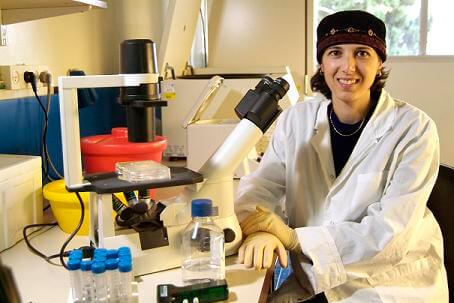"We showed that the three-dimensional environment and the engineered blood vessels provide support to the islets - support that is important for the survival of the islets and their activity in secreting insulin," says Professor Shulamit Levenberg from the Faculty of Biomedical Engineering

The Technion researchers were able to build a three-dimensional array of sponges containing pancreatic islets surrounded by a network of blood vessels. This is reported by the scientific journal PLoS ONE.
"We showed that the three-dimensional environment and the engineered blood vessels provide support to the islets - support that is important for the survival of the islets and their activity in secreting insulin," says Professor Shulamit Levenberg from the Faculty of Biomedical Engineering. "We showed that these sponges produced in the laboratory can be implanted under the skin and cure a diabetic mouse. Apparently, the ability to increase the vascularization of the islets and support the survival of the islets and increase after the transplantation made it possible to transplant a four times smaller amount of islets than is customary in transplants into mice and still get a decrease in blood sugar levels and rescue from the diabetic condition."
The mechanism that leads to failure in pancreatic islet transplantation is still not fully clear, but the accepted opinion is that it is related to ischemic damage - and a delay in the formation of new blood vessels. According to the Technion researchers' hypothesis, blood vessels also play an active role in cell-cell communication that supports the survival of pancreatic islets and their function. To test the hypothesis, the researchers developed a three-dimensional network of endothelial blood vessels in engineered pancreatic tissues derived from islets, fibroblasts, and endothelial cells. This triple array, seeded on highly porous polymeric scaffolds, mimics the natural anatomical context of the pancreatic vasculature. "We showed that the increase in the survival rate of the islets is directly proportional to the formation of endothelial tubes around them," says Professor Levenberg.
"Addition of fibroblasts to pancreatic islet cultures and endothelial cells encouraged the formation of the blood vessel network, which supported islet survival as well as insulin secretion. Many variables - gene expressions, profiles of endothelial cell growth factors, ECM, morphogens and differentiation markers - were very different between two-dimensional culture systems and three-dimensional systems in which the endothelial network was possible, and this difference even increased as a result of the addition of fibroblasts which support the creation of the engineered blood vessels . ".
Transplantation of the engineered islet tissue with blood vessels improved the survival and recordings of the islets in diabetic mice, and even improved their function in lowering the blood glucose level. The Technion researchers hope that these findings herald potential strategies for the preparation of transplantable islets with improved survival chances.
The work was done by research student Karen Francis in Professor Levenberg's laboratory and in collaboration with Yuval Dor from the Hebrew University as part of a joint research grant from the World Youth Diabetes Foundation. A follow-up project investigating the effect of the blood vessel network and the three-dimensional tumor on human islets is currently underway in the laboratory - jointly funded by the World Youth Diabetes Foundation and the National Science Foundation.

3 תגובות
lots of success!!!
Seems like pretty out of the box thinking. Creating a different organ from the original pancreas that will be completely biological and will serve the same function. (Or maybe the ambition is to create a complete pancreas at the end?)
When do human trials begin?
willing to volunteer